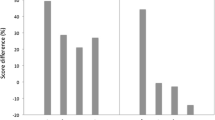Abstract
This paper addresses the problem of speech intelligibility enhancement by subband adaptive filtering algorithms in a blind framework. Recently in Djendi and Sayoud (Int J Speech Technol 22:391–406, 2019), we have proposed a subband adaptive algorithm based on the forward blind source separation structure that is efficient for acoustic noise reduction and speech intelligibility enhancement applications. In this paper, we propose a novel subband domain implementation of the backward blind source separation structure combined with a modified version of the fast normalized least mean square (FNLMS) algorithm. The new proposed subband algorithm is efficient in improving the speech signal intelligibility without introducing any distortion at the output. A fair comparison of the proposed backward subband FNLMS algorithm with other fullband type algorithms is presented. This comparison is based on the evaluation of several objective criteria. The obtained results show the best performance of the proposed subband algorithm in terms of speed convergence.










Similar content being viewed by others
References
Benesty, J., & Chen, J. (2011). Optimal time-domain noise reduction filters, a theoretical study. Berlin, Germany: Springer-Verlag.
Boll, S. F. (1979). Suppression of acoustic noise in speech using spectral subtraction. IEEE Transactions on Acoustics Speech and Signal Processing,27(2), 113–120.
Bouchard, M. (2003). Multichannel affine and fast affine projection algorithms for active noise control and acoustic equalization systems. IEEE Transactions on Speech and Audio Processing,11(1), 54–60.
Djendi, M., & Bendoumia, R. (2013). A new adaptive filtering subband algorithm for two channel acoustic noise reduction and speech enhancement. Computers & Electrical Engineering,39(8), 2531–2550.
Djendi, M., Gilloire, A., Scalart, P. (2006). Noise cancellation using two closely spaced microphones: Experimental study with a specific model and two adaptive algorithms. In IEEE int. conf. ICASSP, Toulouse, France, 14–19 May 2006, Vol. 3, pp. 744–748.
Djendi, M., & Sayoud, A. (2019). A new dual subband fast NLMS adaptive filtering algorithm for blind speech quality enhancement and acoustic noise reduction. International Journal of Speech Technology,22, 391–406.
Djendi, M., & Zoulikha, M. (2014). New automatic forward and backward blind sources separation algorithms for noise reduction and speech enhancement. Computers & Electrical Engineering,40, 2072–2088.
Ghribi, K., Djendi, M., & Berkani, D. (2016). A new wavelet-based forward BSS algorithm for acoustic noise reduction and speech quality enhancement. Applied Acoustics,105, 55–66.
Gilloire, A., & Vetterli, M. (1988). Adaptive filtering in subbands. In: Proceedings of the ICASSP, pp. 1572–1575.
Habets, E. A. P., Benesty, J., Gannot, S., & Cohen, I. (2009). The MVDR beamformer for speech enhancement. In Speech processing in modern communication, pp. 225–254.
Haykin, S. (2002). Adaptive filter theory (4th ed.). Upper Saddle River, NJ: Prentice-Hall.
Henni, R., Djendi, M., & Djebari, M. (2019). A new efficient two-channel fast transversal adaptive filtering algorithm for blind speech enhancement and acoustic noise reduction. Computer and Electrical Engineering,73, 349–368.
Hu, Y., & Loizou, P. C. (2008). Evaluation of objective quality measures for speech enhancement. IEEE Transactions on Audio, Speech and Language Processing,16(1), 229–238.
Lee, K. A., & Gan, W. S. (2004). Improving convergence of the NLMS algorithm using constrained subband updates. IEEE Signal Processing Letters,11(9), 736.
Lee, K.-A., Gan, W.-S., & Kuo, S. M. (2010). Subband adaptive filtering theory and implementation. Wiley: New York.
Ozeki, K., & Umeda, T. (1984). An adaptive filtering algorithm using an orthogonal projection to an affine subspace and its properties. Electron Commun Jpn,67A(5), 19–27.
Pradhan, S. S., & Reddy, V. U. (1999). A new approach to subband adaptive filtering. IEEE Transactions on Signal Processing,47(3), 655–664.
Rabiner, L., & Juang, B. H. (1993). Fundamentals of speech recognition. Englewood Cliffs: Prentice-Hall.
Sayed, A. H. (2003). Fundamentals of adaptive filtering. New York: Wiley.
Sayoud, A., Djendi, M., & Guessoum, A. (2018a). A two-sensor fast adaptive algorithm for blind speech enhancement. In: International conference on engineering & MIS, Istanbul, Turkey.
Sayoud, A., Djendi, M., Medahi, S., & Guessoum, A. (2018b). A dual fast NLMS adaptive filtering algorithm for blind speech quality enhancement. Applied Acoustics,135, 101–110.
Slock, D. T. M., & Kailath, T. (1991). Numerically stable fast transversal filters for recursive least-squares adaptive filtering. IEEE Trans Signal Procjan,39(1), 92–114.
Van Gerven, S., & Van Compernolle, D. (1992). Feedforward and feedback in symmetric adaptive noise canceller: Stability analysis in a simplified case. In: Eusipco92, European Signal Processing Conf. Brussels, Belgium, pp. 1081–1084 (August).
Van Gerven, S., & Van Compernolle, D. (1995). Signal separation by symmetric adaptive decorrelation: Stability, convergence, and uniqueness. IEEE Trans Signal Proc,74(3), 1602–1612.
Widrow, B., & Goodlin, R. C. (1975). Adaptive noise cancelling: Principles and applications. Proceedings of the IEEE,63(12), 1692–1716.
Author information
Authors and Affiliations
Corresponding author
Additional information
Publisher's Note
Springer Nature remains neutral with regard to jurisdictional claims in published maps and institutional affiliations.
Rights and permissions
About this article
Cite this article
Sayoud, A., Djendi, M. Efficient subband fast adaptive algorithm based-backward blind source separation for speech intelligibility enhancement. Int J Speech Technol 23, 471–479 (2020). https://doi.org/10.1007/s10772-020-09715-w
Received:
Accepted:
Published:
Issue Date:
DOI: https://doi.org/10.1007/s10772-020-09715-w




